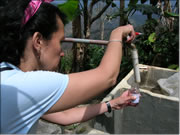Assessing Access to Water and Sanitation
 It is common for many international organizations to use access to safe drinking water and hygienic sanitation facilities as a measure for progress in the fight against poverty, disease, and death. It is also considered to be a human right, not a privilege, for every man, woman, and child to have access to these services. Even though progress has been made in the last decade to provide safe drinking water and sanitation to people throughout the world, there are still billions of people that lack access to these services every day.
It is common for many international organizations to use access to safe drinking water and hygienic sanitation facilities as a measure for progress in the fight against poverty, disease, and death. It is also considered to be a human right, not a privilege, for every man, woman, and child to have access to these services. Even though progress has been made in the last decade to provide safe drinking water and sanitation to people throughout the world, there are still billions of people that lack access to these services every day.
Drinking Water Sources
According to the United Nations, in 2006, 84% of the developing world had access to an improved drinking water source, leaving 1.1 billion people lacking access to an improved source of water (1).
Access to safe drinking water is measured by the percentage of the population with access and using improved drinking water sources.
Improved drinking water sources should, but do not always, provide safe drinking water, and include:
- Household connection
- Public standpipe
- Borehole
- Protected dug well
- Protected spring
- Rainwater collection
Unimproved drinking water sources include:
- Unprotected well
- Unprotected spring
- Rivers or ponds
- Vendor-provided water
- Bottled water*
- Tanker truck water (2)
* Bottled water is not considered improved due to limitations in the potential quantity, not quality, of the water.
Sanitation Facilities
According to the United Nations, in 2006, only 53% of the developing world had access to an improved sanitation facility, with Sub-Saharan Africa and Southern Asia having only 31% and 33%, respectively (1). Almost a quarter of the developing world’s population lives without ANY FORM of sanitation. An additional 15% use facilities that do not adequately separate human waste from human contact (1).
Access to sanitation is measured by the percentage of the population with access and using improved sanitation facilities.
Improved sanitation facilities usually ensure privacy and adequate hygiene, and include:
- Connection to a public sewer
- Connection to a septic system
- Pour-flush latrine
- Simple pit latrine**
- Ventilated improved pit latrine
Unimproved sanitation facilities include:
- Public or shared latrine
- Open pit latrine
- Bucket latrine (2)
** Only a portion of poorly defined categories of latrines are included in sanitation coverage estimates.
1. The United Nations. The Millennium Development Goals Report 2008. Available at http://www.un.org/millenniumgoals/pdf/The%20Millennium%20Development%20Goals%20Report%202008.pdf ![]() .
.
2. UNICEF and WHO. Meeting the MDG Drinking Water and Sanitation Target: A Midterm Assessment of Progress. Available at http://www.who.int/water_sanitation_health/monitoring/jmp04.pdf ![]() .
.
![]() This icon indicates a link leading outside of this CDC Web site. While this external link provides additional information that is consistent with the intended purpose of the Centers for Disease Control and Prevention (CDC), not all external links will lead to federal websites. CDC cannot attest to the accuracy of a non-federal site, and linking to a non-federal site does not constitute an endorsement by CDC or any of its employees of the sponsors or the information and products presented on the site. You will be subject to the destination site’s privacy policy when you follow any link so indicated.
This icon indicates a link leading outside of this CDC Web site. While this external link provides additional information that is consistent with the intended purpose of the Centers for Disease Control and Prevention (CDC), not all external links will lead to federal websites. CDC cannot attest to the accuracy of a non-federal site, and linking to a non-federal site does not constitute an endorsement by CDC or any of its employees of the sponsors or the information and products presented on the site. You will be subject to the destination site’s privacy policy when you follow any link so indicated.
![]() Please note: Some of these publications are available for download only as *.pdf files. These files require Adobe Acrobat Reader in order to be viewed. Please review the information on downloading and using Acrobat Reader software.
Please note: Some of these publications are available for download only as *.pdf files. These files require Adobe Acrobat Reader in order to be viewed. Please review the information on downloading and using Acrobat Reader software.
- Page last reviewed: October 22, 2008
- Page last updated: October 22, 2008
- Content source: Centers for Disease Control and Prevention
Contact Us:
- Centers for Disease Control and Prevention
1600 Clifton Rd
Atlanta, GA 30333 - 800-CDC-INFO
(800-232-4636)
TTY: (888) 232-6348
24 Hours/Every Day - healthywater@cdc.gov

